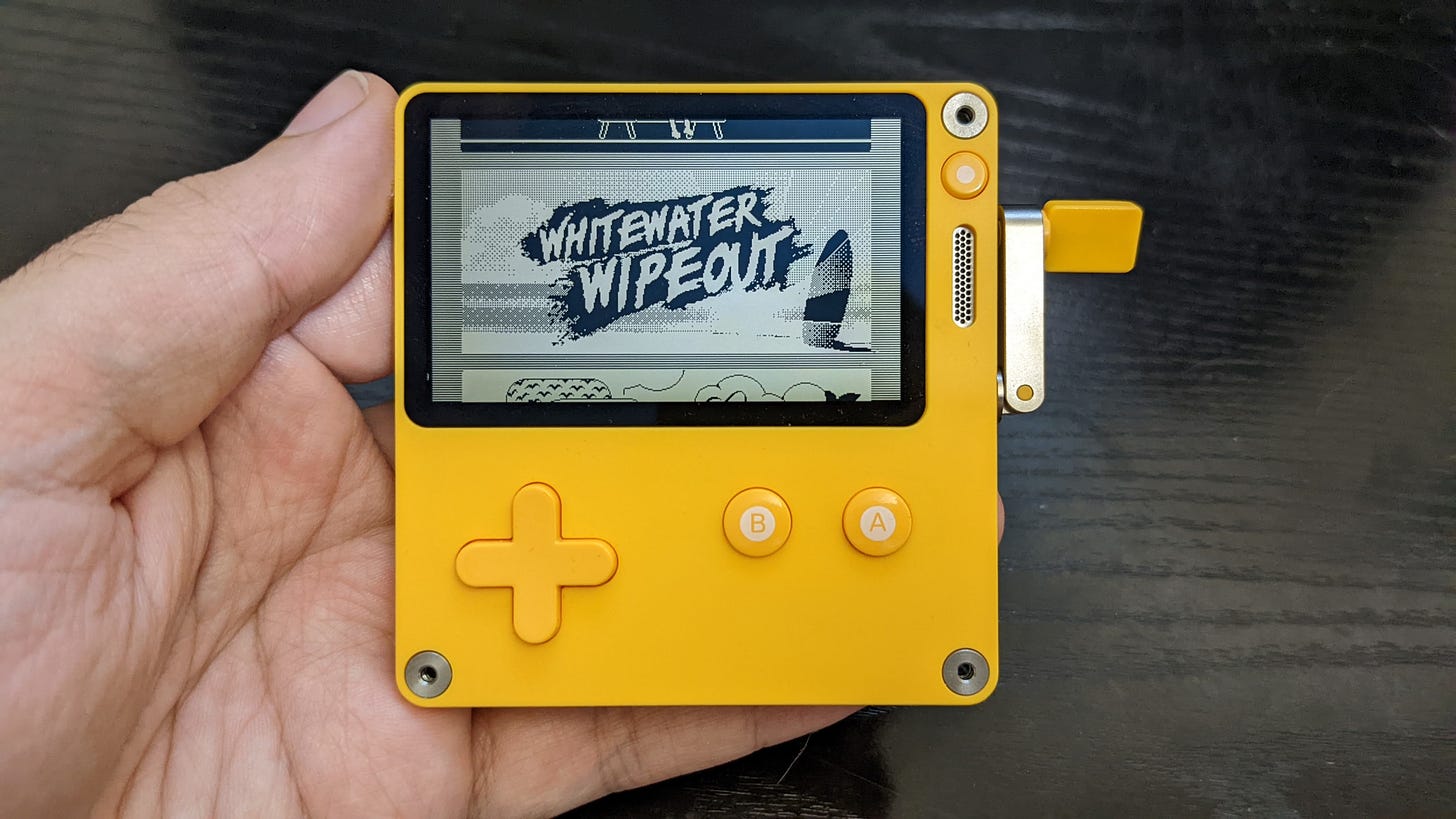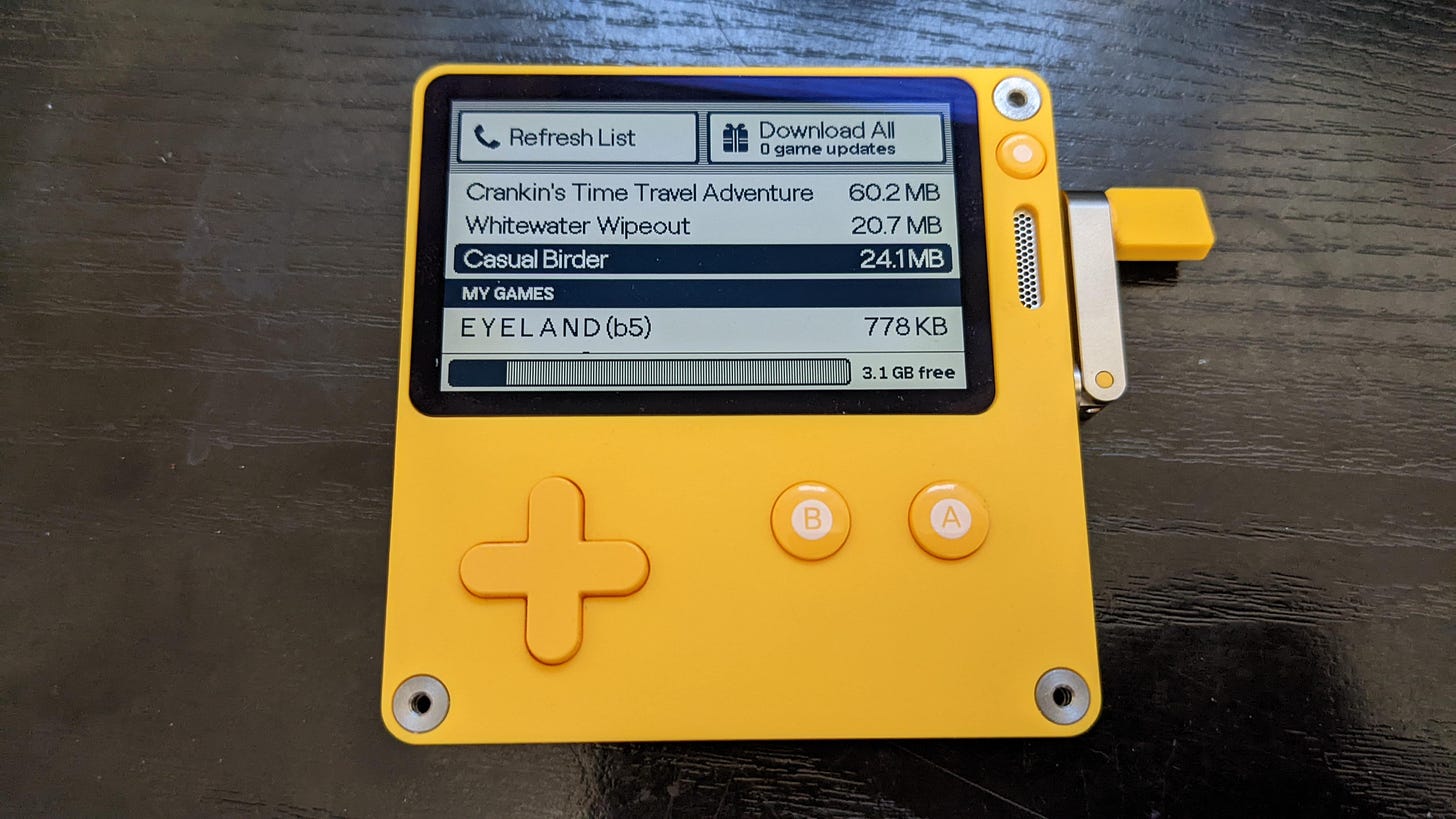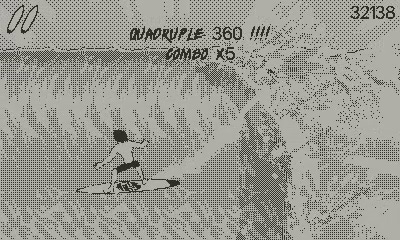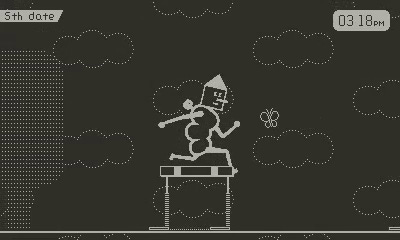As a very cool and modern gamer, I went ahead and pre-ordered the Playdate as soon as it was available. For anyone who’s not as cool as me and doesn’t know, the Playdate is a new handheld gaming console; it’s tiny, and it’s yellow, and it rules. It was created by Panic, the video game company that produced such indie favorites as Untitled Goose Game and Firewatch, and it was largely based on that track record that I felt confident spending my money on this thing. (I am also a big proponent of spending my money on things.) As a gaming console, the Playdate has several unique features: a high contrast black and white screen, an eye catching bright yellow coat of paint, a conveniently small form factor, and oh yeah, there’s a big old crank on the side of it.
No, this crank does not power the device, despite what everyone who first looks at it assumes. The crank is just another form of control input for developers to use as they see fit in their games. So far I’ve seen one game use it as a tool to focus a camera, one use it to move a character forward (or backward), while others use it only to scroll through cut scenes, or maybe not at all. It’s a crank, it’s weird, and I love it.
Needless to say, I’m a big fan of the Playdate so far. It’s really hitting all the right buttons (and turning all the right cranks) for me as an experience. The thing that I’ve found myself enjoying the most though, aside from the games themselves, is the way in which they’re delivered to me.
Included with the purchase of a Playdate is a set of twenty-four games known collectively as Season One. However, you don’t get access to all of these games right away. You get access to two of them as soon as your system is turned on. Then, the following Monday, two more games will be automatically downloaded to your device. This process repeats itself the following Monday, and the Monday after that, and so on, for a total of twelve weeks. When the time comes, a cute little purple light blinks, alongside a message on screen letting you know that there are new games available to download. Unlock the system and you’re even treated to a cute little animation wherein those games are unwrapped like a special present. (It’s cute.) I was lucky to receive my playdate pretty early, and I’m currently on Week 4 of Season One. (The experience isn’t synchronized across devices. Depending on when players receive their Playdates, they could be in different weeks at the same time.)
Referring to these games as a “season” is appropriate because it hews to the old school model of releasing episodes of a television season one week at a time. In a post-Netflix world, the people are all about the binge, but we’ve seen a return to the old ways with examples like the recent Marvel shows on Disney+. Were all these games released at once, they’d be bingeable and pretty easy to race through, but then there’d be nothing else to do with the device. (It’s new and fairly niche, so there really isn’t a ton of third party content available for the thing just yet.) Because games are only coming out two at a time, I get something to look forward to each week, plus it gives me the chance to really savor them. The Playdate is going to be in my head longer, entertain me longer, and ultimately feel like a better use of my money. Even though the cost of these games was included in the cost of the device itself, it feels like I’m getting a little present on there each Monday. And because of that, it’s become an essential item for me to check in on. This thing isn’t going into a drawer any time soon.
Having every title available all at once would’ve been overwhelming, too. Where would I start? What would I play first? How long would I play it for? (I’m incredibly indecisive!!) Probably, I’d bounce between games like a madman, not fully appreciating any of them. I might also bounce off of a game quickly if it didn’t immediately interest me, and that brings me to the other thing I love about this format: Only having two games a week to play forces me to actually play those games. This might sound like a negative to some people, especially since I phrased it as being “forced” to do something (that one’s on me). As a result however, I’ve found that some of my favorite titles on the system have been games I might not have given a chance otherwise.
Take Whitewater Wipeout, one of the games that comes loaded onto the system right at the start. This is a surfing game that’s all about doing cool tricks and getting high scores, and it exclusively uses the crank for its controls. Not being used to using a crank to surf, it took me a long time to get the hang (ten?) of this one. My first several attempts were pretty pathetic, and my scores were embarrassingly low. Fortunately, because I had only one other game to turn to, I found myself coming back to play. Here and there, I’d give it another go, usually for just a few minutes at a time. Eventually, it clicked. Now I’ve got a handle on the precise motions and timing required with the crank to pull off quadruple 360s consistently. I’m still not good enough to get on any leaderboards, but at least my brain comprehends the basic flow (like water? haha). Underneath the somewhat unfriendly surface (like water again? haha), I discovered Whitewater Wipeout to be a really addicting and satisfying little arcade surfboard game.
Another example is the Week 2 title, Crankin’s Time Travel Adventure. This is a side scrolling game from Keita Takahashi (of Katamari Damacy fame) in which you must move a robot past obstacles to reach his date at the end of the level. This is another crank-only game. Crank forward to move the robot forward, crank backward to move him back, and preferably out of the way of rampaging pigs, birds, and butterflies. It’s a very simple premise, but Crankin can be extremely frustrating. Levels are brief, but make one wrong move, and you have to start from the beginning again. Most levels will take you multiple tries, requiring lots of trial and error and memorization.
There was a time when I thought I would never reach the end of Crankin, and I was fine with that, feeling relatively satisfied with what I’d seen of the game already. But then, because I had finished the other games available to me, I ended up going back to it, playing only a little here and there, just like with Whitewater Wipeout. Again, it eventually clicked, and I’ve now completed every level. I still have complaints about the game, and found many of the later aspects to be just as maddening as the early ones, but I managed to find the joy in overcoming those roadblocks. Had I had more to do, there’s a very good chance I never would’ve made that connection.
In a world where we’re overrun by new media every single day, the Playdate is a refreshing change of pace. Like everyone else, I’ve got an endless backlog of video games, and there’s never time to play them all. Frequently, I’ll start a game up and never come back to it, but who knows what I might be missing out on if I explored it further? The Playdate has offered me the opportunity to take things slow, giving games multiple chances even if they don’t grab me right away. So far, they’ve all been experiences I’m glad I had, even with their flaws.
Of course, all of this could change once the Playdate has been out a while longer. There’s talk of a Season 2 coming sometime after Season 1 ends, and eventually there will be a store app offering additional games. Personally, I hope that Panic still finds a way to maintain the magic of the drip feed for as long as possible. It’s maybe a tough sell for most customers, asking them to take a leap of faith and pre-order games blindly. But as someone who was willing to take that chance, I’m loving the joyous surprise of it all.
Unfortunately, if you buy a Playdate right now, you’re not likely to receive it until 2023 due to the manufacturing backlog. But if you love the idea of playing new, weird little games you wouldn’t have heard of otherwise on a weekly basis, I really recommend it.








very cute; very surprising that this device has profit potential in 2022/2023. Have you heard of UFO50? My buddy Jon is one of the designers for that project; 50 full-featured (and mostly full-length) retro-style video games built over about 8 years from a team of 3. I have no idea what kind of business plan they have but I think the project is aimed for a low price point for release this year or early next year.